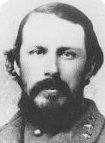 Open main menu
Open main menu
 Open main menu
Open main menu

E.P. Alexander
(1835 - 1910)
Home State: Georgia
Education: US Military Academy, West Point, NY, Class of 1857;Class Rank: 3
Command Billet: Chief of Ordnance
Branch of Service: Engineers
Before Sharpsburg
After graduation from West Point he served as a US Army Engineer, being appointed 2nd Lieutenant on 10 October 1858. He served as an instructor at the Academy, on expeditions to Utah and the Washington Territory, and on the West Coast before resigning to go with the Confederacy to date from 1 May 1861.
He was appointed Captain of Engineers, CSA, and charged with establishing the Confederate Signal Corps, serving as signal officer at First Manassas and observing from a balloon during the Seven Days near Richmond. By the end of 1861 he was appointed Chief of Ordnance for the Army of Northern Virginia (ANV).
He was appointed Major, CSA in April 1862, and Lieutenant Colonel shortly after. He was appointed full Colonel in July.
On the Campaign
Of the Campaign Colonel Alexander later wrote:
"My reserve ordnance train, of about 80 wagons, had accompanied Lee's headquarters to Hagerstown, and had also followed the march back to Boonsboro. I was now [14-15 Sept] ordered to cross the Potomac at Williamsport, and go thence to Shepherdstown, where I should leave the train and come in person to Sharpsburg. The moon was rising as I started, and about daylight I forded the Potomac, unaware of having had a narrow escape from capture, with my train, by Gregg's brigade of cavalry. This brigade had escaped that night from Harper's Ferry, and crossed our line of retreat from Boonsboro. It had captured and destroyed the reserve ordnance train, of 45 wagons of Longstreet's corps."
".. I have already told of my being sent on the 16th to Harper's Ferry to remove the captured ordnance stores and to bring what was available for use to Sharpsburg. I sent to Winchester 49 field-pieces and 24 mountain howitzers, and quite a lot of artillery ammunition not suitable for our calibres ... in the afternoon [of 17 September] from Bolivar Heights, I could see the smoke of the conflict and the incessant bursting in the air of shells and shrapnel over the field where Burnside made his advance and was beaten back by A. P. Hill. "
The rest of the War
In December 1862 he began service as Chief of Artillery of Longstreet's Corps, seeing action at Chancellorsville, Gettysburg, and Knoxville in that role. He is probably best known for commanding the prepatory artillery bombardment of the Federal lines at Gettysburg prior to Pickett's Charge on 3 July 1863. In February 1864 he wa appointed Brigadier General and commanded at Spotsylvania, Cold Harbor, and Petersburg, where he was wounded in action. He was present with the Army at the surrender Appomattox Courthouse in April 1865.
After the War
He was mathematics and engineering professor at the University of South Carolina. He was manager and president of a number of railroads from 1871 to 1892, capitol commissioner of Georgia (83-88), and a director of the Union Pacific Railroad (85-87). He was an arbitrator of the boundary between Costa Rica and Nicaragua (1888), and later farmed rice on South Island, South Carolina.
References & notes
More on the Web
His papers are in the collection of UNC Chapel Hill.
Birth
05/26/1835; Wilkes County, GA
Death
04/28/1910; Savannah, GA; burial in Magnolia Cemetery, Augusta, GA
1 Heitman, Francis Bernard, Historical Register and Dictionary of the United States Army 1789-1903, 2 volumes, Washington DC: US Government Printing Office, 1903, pg. 156 [AotW citation 591]
2 Georgia Humanities Council, and the University of Georgia Press, The New Georgia Encyclopedia, Published c. 2004, <http://www.georgiaencyclopedia.com/>, Source page: /nge/Article.jsp?id=h-823 [AotW citation 592]
3 Article transcribed online by Keith Giddeon.
Johnson, Rossiter (editor), Twentieth Century Biographical Dictionary of Notable Americans, 10 volumes, Boston: The Biographical Society, 1904, Vol. X [AotW citation 593]
4 Alexander, Edward Porter, Military memoirs of a Confederate: A Critical Narrative, New York: Charles Scribner's Sons, 1907, pg. 272 [AotW citation 594]
5 Uriguen, Mikel, Photo Gallery (Generals and Brevet Generals), Generals of the Civil War, Published c. 1998, first accessed 01 January 1998, <http://www.generalsandbrevets.com/>, Source page: /sga/alexander.htm [AotW citation 595]